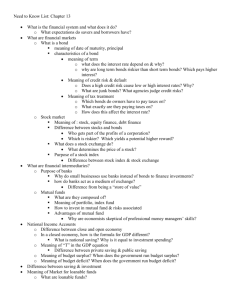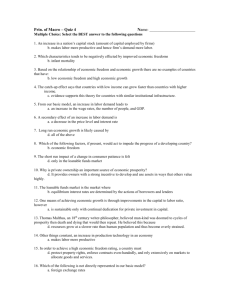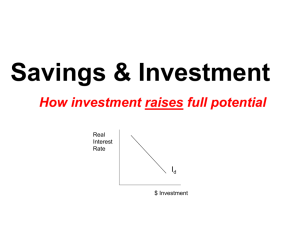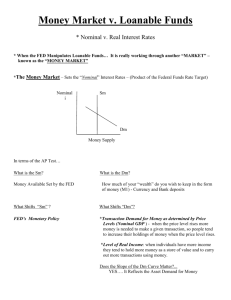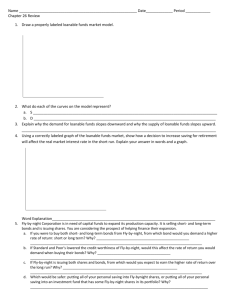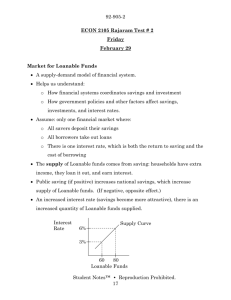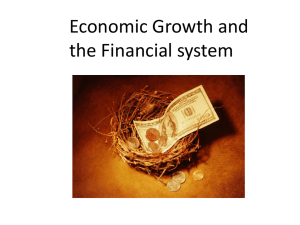13 Saving, Investment, and the Financial System Chapter
advertisement
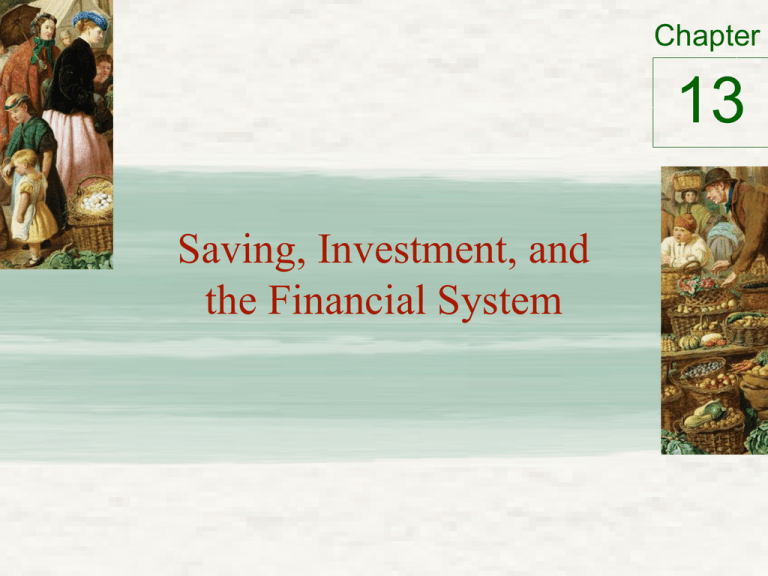
Chapter 13 Saving, Investment, and the Financial System Financial Institutions in the U.S. Economy • Financial markets – Bond market • Enables firms or financial institutions to “issue” debt and “borrow” money • Government: Treasury bills • Corporations: another way to raise cash for expenses –corporate bonds/debt – Stock Market • Another route for raising cash: sell shares of stock (value in the company) for cash 2 Financial Institutions in the U.S. Economy • Financial intermediaries – Financial institutions • Savers can indirectly provide funds to borrowers • Banks – Take in deposits from savers • Banks pay interest – Make loans to borrowers • Banks charge interest – Facilitate purchasing of goods and services • Checks – medium of exchange 3 Saving & Investment in National Income Accounts • Some important identities • Gross domestic product (GDP) – Total income – Total expenditure • Y = C + I + G + NX • Y= gross domestic product GDP • C = consumption • G = government purchases • NX = net exports 4 Saving & Investment in National Income Accounts • Some important identities • Closed economy – Doesn’t interact with other economies – NX = 0 • Open economy – Interact with other economies – NX ≠ 0 5 Saving & Investment in National Income Accounts • Some important identities • Assumption: close economy: NX = 0 –Y = C + I + G • National saving (saving), S – Total income in the economy that remains after paying for consumption and government purchases – Y – C – G = I; S = Y – C - G –S = I 6 Saving & Investment in National Income Accounts • Some important identities • T = taxes minus transfer payments –S = Y – C – G – S = (Y – T – C) + (T – G) • Private saving, Y – T – C – Income that households have left after paying for taxes and consumption • Public saving, T – G – Tax revenue that the government has left after paying for its spending 7 Saving & Investment in National Income Accounts • Some important identities • Budget surplus: T – G > 0 – Excess of tax revenue over government spending • Budget deficit: T – G < 0 – Shortfall of tax revenue from government spending 8 Saving & Investment in National Income Accounts • The meaning of Saving and Investing • S=I • Saving = Investment – For the economy as a whole – One person’s savings can finance another person’s investment 9 The Market for Loanable Funds • Supply and demand of loanable funds – Source of the supply of loanable funds • Saving – Source of the demand for loanable funds • Investment – Price of a loan = real interest rate • Borrowers pay for a loan • Lenders receive on their saving 10 Figure 1 The market for loanable funds Interest Rate Supply 5% Demand 0 $1,200 Loanable Funds (in billions of dollars) The interest rate in the economy adjusts to balance the supply and demand for loanable funds. The supply of loanable funds comes from national saving, including both private saving and public saving. The demand for loanable funds comes from firms and households that want to borrow for purposes of investment. Here the equilibrium interest rate is 5 percent, and $1,200 billion of loanable funds are supplied 11 and demanded. The Market for Loanable Funds • Policy 1: saving incentives • Shelter some saving from taxation – Affect supply of loanable funds – Increase in supply • Supply curve shifts right – New equilibrium • Lower interest rate • Higher quantity of loanable funds – Greater investment 12 Figure 2 Saving incentives increase the supply of loanable funds Interest Rate Supply, S1 S2 1. Tax incentives for saving increase the supply of loanable funds . . . 5% 4% 2. . . . Which reduces the equilibrium interest rate . . . Demand 0 $1,200 $1,600 Loanable Funds (in billions of dollars) 3. . . . and raises the equilibrium quantity of loanable funds. A change in the tax laws to encourage Americans to save more would shift the supply of loanable funds to the right from S1 to S2. As a result, the equilibrium interest rate would fall, and the lower interest rate would stimulate investment. Here the equilibrium interest rate falls from 5 percent to 4 percent, and the equilibrium quantity of loanable funds saved and invested rises from $1,200 13 billion to $1,600 billion. The Market for Loanable Funds • Policy 2: investment incentives • Investment tax credit – Affect demand for loanable funds – Increase in demand • Demand curve shifts right – New equilibrium • Higher interest rate • Higher quantity of loanable funds – Greater saving 14 Figure 3 Investment incentives increase the demand for loanable funds Interest Rate Supply 1. An investment tax credit increases the demand for loanable funds . . . 6% 5% 2. . . . which raises the equilibrium interest rate . . . D2 Demand, D1 0 $1,200 $1,400 Loanable Funds (in billions of dollars) 3. . . . and raises the equilibrium quantity of loanable funds. If the passage of an investment tax credit encouraged firms to invest more, the demand for loanable funds would increase. As a result, the equilibrium interest rate would rise, and the higher interest rate would stimulate saving. Here, when the demand curve shifts from D1 to D2, the equilibrium interest rate rises from 5 percent to 6 percent, and the equilibrium quantity of 15 loanable funds saved and invested rises from $1,200 billion to $1,400 billion. The Market for Loanable Funds • Policy 3: government budget deficits and surpluses • Government - starts with balanced budget – Then starts running a budget deficit • Change in supply of loanable funds • Decrease in supply – Supply curve shifts left • New equilibrium – Higher interest rate – Smaller quantity of loanable funds 16 Figure 4 The effect of a government budget deficit Interest Rate S2 6% Supply, S1 1. A budget deficit decreases the supply of loanable funds . . . 5% 2. . . . which raises the equilibrium interest rate . . . Demand Loanable Funds (in billions of dollars) 3. . . . and reduces the equilibrium quantity of loanable funds. 0 $800 $1,200 When the government spends more than it receives in tax revenue, the resulting budget deficit lowers national saving. The supply of loanable funds decreases, and the equilibrium interest rate rises. Thus, when the government borrows to finance its budget deficit, it crowds out households and firms that otherwise would borrow to finance investment. Here, when the supply shifts from S1 to S2, the equilibrium interest rate rises from 5 percent to 6 percent, and the equilibrium 17 quantity of loanable funds saved and invested falls from $1,200 billion to $800 billion. The Market for Loanable Funds • Policy 3: government budget deficits and surpluses • Crowding out – Decrease in investment – Results from government borrowing • Government - budget deficit – Interest rate rises – Investment falls 18 The Market for Loanable Funds • Policy 3: government budget deficits and surpluses • Government – budget surplus – Increase supply of loanable funds – Reduce interest rate – Stimulates investment 19 The history of U.S. government debt • Debt of U.S. federal government – As a percentage of U.S. GDP – Fluctuated • 0% of GDP in 1836 to 107% of GDP in 1945 • 30-40% of GDP in recent years • War – primary cause of fluctuations in government debt: – Debt financing of war – appropriate policy • Tax rates – smooth over time – Shifts part of the cost of wars to future generations 20 Figure 5 The U.S. government debt The debt of the U.S. federal government, expressed here as a percentage of GDP, has varied throughout history. Wartime spending is typically associated with substantial increases in government debt. 21 The history of U.S. government debt • Recent large increase in government debt – Cannot be explained by war – Around 1980 – President Ronald Reagan, 1981 • Committed to smaller government and lower taxes • Cutting government spending - more difficult politically than cutting taxes – Period of large budget deficits – Government debt: 26% of GDP in 1980 to 50% of GDP in 1993 22 The history of U.S. government debt • President Bill Clinton, 1993 – Major goal - deficit reduction – And Republicans took control of Congress, 1995 • Deficit reduction – Substantially reduced the size of the government budget deficit – Eventually: surplus – By the late 1990s - debt-GDP ratio - declining 23 The history of U.S. government debt • President George W. Bush – Debt-GDP ratio - started rising again – Budget deficit • Several major tax cuts • 2001 recession - decreased tax revenue and increased government spending • War on terrorism - increases in government spending 24 Figure More Recent Data 25 The Current Market Liquidity Trap • liquidity trap • A liquidity trap is defined as a situation in which the short-term nominal interest rate is near zero • Keynes emphasizes that increasing money supply in a liquidity trap has no effect on interest rates, therefore does not increase in Investment and policy will be ineffective – Keynes was looking at increasing the money supply – Current policy makers are looking at Budget Deficits and increased federal borrowing – does it “crowd out” private sector investment 26 In “Normal” Times Decrease in Budget Deficit -> Increase Supply of Money/Loanable Funds -> Lowers Interest Rate -> Increases Investment 27 In a “Liquidity Trap” Can’t lower interest rate -> No Change in Investment 28 Did Austerity Work? 29 A Lab Experiment: US vs UK policy differences 30 An Economics Laboratory Experiment • One of the frustrations of economics is that it is hard to carry out scientific experiments and prove things beyond reasonable doubt. • Not in this case. Osborne’s stubborn refusal to change course—“Turning back would be a disaster,” what has been happening in Britain amounts to a “natural experiment” to test the efficacy of austerity economics. • But from a historical and scientific perspective, it is an invaluable case study. 31 And What Happened? • American economy, while hardly racing ahead, has fared considerably better than its British counterpart. Between 2010 and 2012, G.D.P. growth here has averaged about 2.1 per cent. For the U.K., the figure is 0.9 per cent. • What may be more is that the United States, while sticking with Keynesian stimulus policies, has also managed to bring down the size of its deficit, relative to G.D.P., almost as rapidly as Britain has 32


